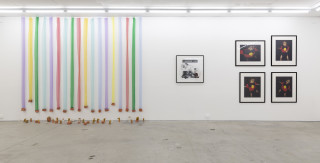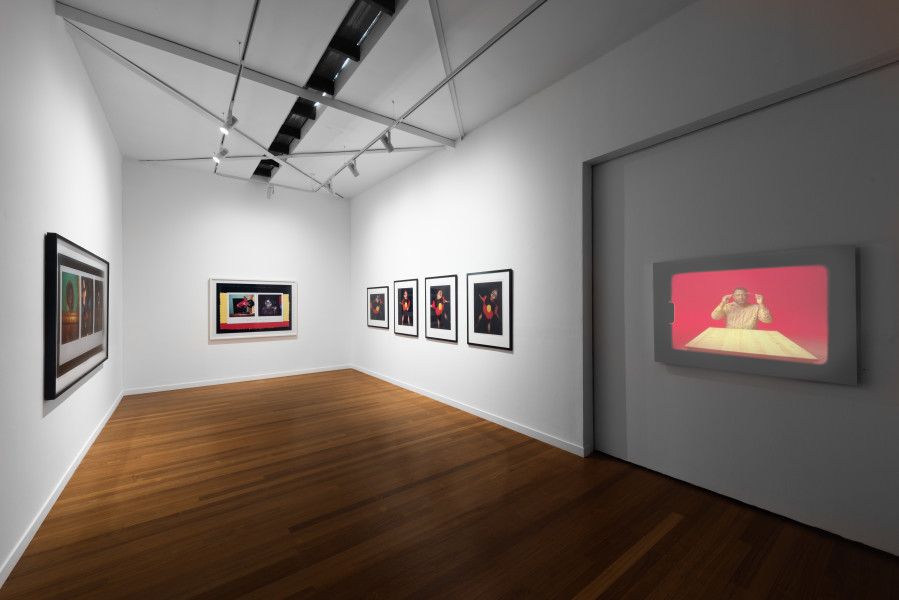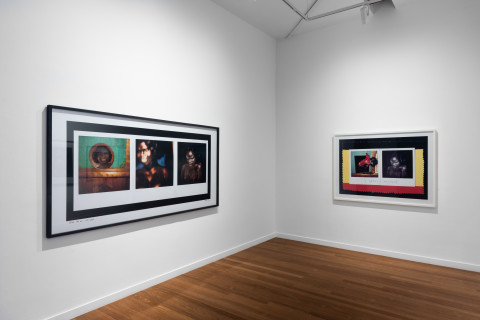Roslyn Oxley9 Gallery is delighted to present an exhibition of new and historic works by Destiny Deacon.
Exhibition Dates: 9 March – 6 April 2024
When Destiny Deacon was 13, she travelled in the Aboriginal Community Bus to La Perouse to protest the Bicentenary of Captain Cook’s arrival on Australia shores. When she was 14, she joined protestors in Melbourne to boycott the Australian Government’s decision to host an all-white Springboks team, amidst international condemnation of South Africa’s apartheid regime. At 15, she travelled to Canberra to protest the removal of the Aboriginal Tent Embassy in front of Parliament House, and at 25, she travelled to Brisbane to protest the 1982 Commonwealth Games, a demonstration that was significant in placing the issue of Indigenous land rights on a national and international stage.
For Destiny, political activism helped form her identity.1 The impact of these major protests can be felt in small wins: in the 50th anniversary of the Aboriginal Tent Embassy in 2022, marking the longest continuous protest for Indigenous land rights in the world, and in the 2023 formal recognition and legislative protection of the ‘old La Perouse Mission site’ for its heritage significance to its people.
Claire G. Coleman, scholar and close follower of Destiny’s work, says she has never seen a Deacon artwork without a political subtext.2 This commitment to socio-political dissidence is exemplified, notably, in the triptych Blak lik mi (1991) which is widely accepted as the first time an Aboriginal person used the spelling ‘blak’. Growing up, Destiny frequently encountered racial abuse, often hurled from white people calling out, “You little black c---s.” In a simple but powerful act of defiance, Destiny removed the ‘c’ from of ‘black’, reclaiming the term in a symbolic act of self-empowerment.
Myles Russell-Cook, curator of Indigenous Art at the National Gallery of Victoria, says Destiny’s defining of blakness, as opposed to blackness, was a way of distinguishing Aboriginality from skin colour. More than that, however, it was Destiny’s way of self-determining her identity and originating a blakness/blackness that came entirely from within.3 The legacy of this word cannot be understated. Countless Aboriginal people now self-determine as blak, so much so that the 2024 NAIDOC Week theme is “Keep the Fire Burning! Blak, Loud & Proud”.
The triptych itself, along with its counterpart I seen myself (1991), are included in this exhibition of important works by Destiny Deacon. The subject matter of these two images has a convoluted backstory, in many ways emphasising Destiny’s incisive and subversive approach. Both works consist of Destiny’s blurred photographs of painted reproductions of photographs taken in the 1950s by British Australian photographer Axel Poignant for a photographic novel he titled Piccaninny Walkabout (later changed to Bush Walkabout),4 a story of two lost Aboriginal children.
This photo-essay marked one of the first instances of representations of Aboriginal children in print. Poignant’s photographs, intended neither as kitsch nor derogatory, were widely reproduced without his permission or knowledge, eventually becoming sought-after and costly collectibles scattered through antique markets and vintage stores instilled, perhaps, with a sense of knowing irony.
Destiny refers to these types of objects as ‘Koori kitsch’ — discarded bric-a-brac donning Aboriginal cultural designs and motifs that perpetuate overtly racist stereotypes. Her extensive collection of these items, amassed over many years, exists in part because she ‘feels sorry for them’. “In the beginning I wanted to rescue them, because otherwise they’d end up in a white home or something, somewhere no-one would appreciate them,” she says.
Destiny’s collection of Koori kitsch appears in many of her works including her series of four photographic images, Dance little lady (1993), also included in this exhibition. Taking its title from a 1970’s Tina Charles disco track, the plastic doll in Dance little lady adorns the Aboriginal flag as a t-shirt, appearing to dance to a tune we imagine through its title, the lyrics to which become increasingly sinister.5 The doll acts out a female Aboriginal experience speaking of hidden cruelty, and the need to perform for an audience. As author Hannah Fink notes: “The implication [in Destiny’s work] is that kitsch representations of Aboriginal people have come to stand-in for Aboriginal people themselves; like voodoo dolls, these battered junk- shop dollies are mascots of the grotesque incongruity between real and imagined indigeneity. There is nothing vicarious about Indigenous suffering, however, and beneath the jest is the living hurt of a history of poverty and contempt.”6
Whilst the Captain Cook Bicentenary and Aboriginal Tent Embassy protests have been significant in catalysing social and political change, there is no doubt that the scope for improvement is immense. According to the Australian Bureau of Statistics, on 30 June 2023, Aboriginal and Torres Strait Islander people accounted for 33% of the total prison population,7 despite constituting just 3.8 per cent of the Australian adult population.8 The Black Lives Matter movement continues to spotlight instances of systemic racial injustices across the globe, while Australia’s rejection of a proposed constitutional amendment in October 2023, aimed at recognising the First Peoples of Australia by enshrining an Indigenous Voice to Parliament, underscores the ongoing challenges faced by Indigenous communities today.
In an eerie nod to what was to come, the title of Destiny’s single-channel projection displayed in this exhibition, A seat at the table (2022), alludes to the symbolic gesture of granting marginalised voices a platform within decision-making processes – commonly expressed as ‘being given a seat at the table’ – echoing ongoing debates surrounding Indigenous rights and sovereignty in Australia. This cutting and astute new work can be read as Destiny’s acknowledgment of this overdue liberty, poignantly underscoring the lingering absence of Indigenous perspectives in positions of power, despite decades of advocacy, activism and a nationwide vote.
– Tallulah Smith, 2024
---1 Destiny Deacon, quoted in Andrew Stephens, ‘Blak like me: how Destiny Deacon used art to shout back at racists’, The Age, 15 January 2021.
2 Claire G. Coleman, ‘Showing colour’, in DESTINY, National Gallery of Victoria, Melbourne, 2020, p. 55-62.
3 Myles Russell-Cook, ‘DESTINY: the art of Destiny Deacon’, in DESTINY, National Gallery of Victoria, Melbourne, 2020, p. 1-13.
4 Piccaninny is considered an offensive term for an Aboriginal child.
5 Lisa Reihana, ‘Destiny’s children...’, in Destiny Deacon: Walk & don’t look blak, Museum of Contemporary Art, Sydney, 2004, p. 55.
6 Hannah Fink, ‘Destiny Deacon’, Vizard Foundation Art Collection of the 1990s, Potter Museum of Art, University of Melbourne, accessed 6 March 2024.
7 Australian Bureau of Statistics, ‘Aboriginal and Torres Strait Islander prisoners, 2023’, 25 January 2024, ABS, Australian Government, accessed 6 March 2024.
8 Australian Bureau of Statistics, ‘Estimates of Aboriginal and Torres Strait Islander Australians, 2021’, 30 June 2021, ABS, Australian Government, accessed 6 March 2024.

Super 8 single-channel projection with table and chair
24 minutes 30 seconds

from the series Dance Little Lady
Photograph
56 x 70 cm; 76 x 90 cm (paper size), set of 4 images
Edition of 15

Photograph
70 x 56 cm; 90 x 76 cm (paper size), set of 4 images
Edition of 15

Photograph
70 x 56 cm; 90 x 76 cm (paper size), set of 4 images
Edition of 15
 Group Show, A Fictional Retrospective: Gertrude’s First Decade 1985–1995
Group Show, A Fictional Retrospective: Gertrude’s First Decade 1985–1995
Gertrude Contemporary, 2025
 Ten Thousand Suns
Ten Thousand Suns
24th Biennale of Sydney, 2024
 Destiny Deacon
Destiny Deacon
Roslyn Oxley9 Gallery, 2024
 Group Show, The First 40 Years
Group Show, The First 40 Years
Roslyn Oxley9 Gallery, 2024
 Group Show, The Winter Bride
Group Show, The Winter Bride
Roslyn Oxley9 Gallery, 2023
 Thinking Historically in the Present
Thinking Historically in the Present
Sharjah Biennial 15, 2023
 Destiny Deacon DESTINY
Destiny Deacon DESTINY
The Ian Potter Centre, National Gallery of Victoria, Melbourne, 2020-21
 Group Show, Workshop
Group Show, Workshop
University of Queensland Art Museum, Brisbane, 2019
 Destiny Deacon Not Just Fun and Games
Destiny Deacon Not Just Fun and Games
Roslyn Oxley9 Gallery, 2017
 Destiny Deacon RACE
Destiny Deacon RACE
Wyndham Art Gallery, Werribee, VIC, 2016
 Group Show, Melbourne Noir
Group Show, Melbourne Noir
National Gallery of Victoria, Melbourne, 2014-15
 Destiny Deacon Snap out of it
Destiny Deacon Snap out of it
Roslyn Oxley9 Gallery, 2014
 Destiny Deacon Going Strait
Destiny Deacon Going Strait
Roslyn Oxley9 Gallery, 2012
 Destiny Deacon pose-a-rama
Destiny Deacon pose-a-rama
Roslyn Oxley9 Gallery, 2011
 Group Show, Head On Photography Festival
Group Show, Head On Photography Festival
Roslyn Oxley9 Gallery, 2011
 Group Show
Group Show
Roslyn Oxley9 Gallery, 2009-10
Destiny Deacon Clemenger Prize
National Gallery of Victoria, Melbourne, 2009
 Destiny Deacon Gazette
Destiny Deacon Gazette
Roslyn Oxley9 Gallery, 2009
 Destiny Deacon Home Security
Destiny Deacon Home Security
10th Havana Biennial, 2009
 Destiny Deacon Whacked
Destiny Deacon Whacked
Roslyn Oxley9 Gallery, 2007
 Group Show, STOLEN RITUAL
Group Show, STOLEN RITUAL
Roslyn Oxley9 Gallery, 2006-07
 Destiny Deacon Totemistical
Destiny Deacon Totemistical
Roslyn Oxley9 Gallery, 2006
 Destiny Deacon Colour Blinded
Destiny Deacon Colour Blinded
Roslyn Oxley9 Gallery, 2005
 Destiny Deacon Walk & don't look blak
Destiny Deacon Walk & don't look blak
Museum of Contemporary Art Australia, Sydney, 2004-05
 Destiny Deacon d-tour
Destiny Deacon d-tour
Roslyn Oxley9 Gallery, 2003
 Destiny Deacon Postcards from Mummy
Destiny Deacon Postcards from Mummy
Roslyn Oxley9 Gallery, 2003
 Group Show, Dirty Dozen
Group Show, Dirty Dozen
Roslyn Oxley9 Gallery, 2002
 Group Show, The First 20 Years
Group Show, The First 20 Years
Roslyn Oxley9 Gallery, 2002
 Destiny Deacon Forced Into Images
Destiny Deacon Forced Into Images
Roslyn Oxley9 Gallery, 2001







